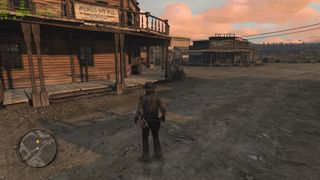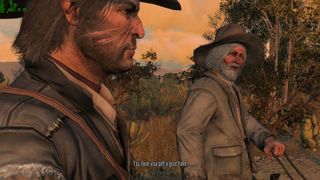Red Dead Redemption may still look like a 14-year-old game, but it's absolutely brilliant on handheld gaming PCs
It was a hell of a long time to wait, though.

PC gamers have waited an awful long time for this to happen. Far too long; inexplicably too long. But finally, we can now play Rockstar's wonderful Red Dead Redemption on our humble boxes and big monitors. Officially, I mean—you could always use emulators in the past—as it's been given a proper port by developers Double Eleven.
And it's a really solid port. I've experienced no glitches, no weird behaviour, no stutters or long load times. It all just works. There's even support for ultrawide monitors, plus AMD FSR 3 and Nvidia DLSS upscaling, with frame generation and Reflex on offer with the latter.
It is just a port, though, so don't expect high-resolution textures, ray-traced reflections, or even something as simple as a photo mode. Red Dead Redemption is a 14-year-old game and despite the lovely art design and decent lighting and shadows, it definitely looks like a game from a decade-and-a-half ago.
But there's one great thing about waiting so long for it to finally appear on PC and it's that it's absolutely brilliant on a handheld.
I first jumped into the game on my Asus ROG Ally X, starting off with low settings. That ran absolutely fine so I began to experiment with the options (there aren't too many of them) and settled on using the high-quality preset with FSR AA, instead of the native FXAA.

On that particular gaming handheld PC, the game ran at just under 50 fps at all times. I know it should do, given its age, but with so many releases of late just being awful in terms of performance and bugs, it's a nice change to be able to just play a game without recourse to messing about with settings.
I then fired it up on a high-end gaming PC (Core i7 14700KF, RTX 4080 Super), whacked every setting to its maximum value, and applied DLAA (Nvidia's AA-powered anti-aliasing). RDR hit the 144 fps cap and just stayed there. Firing up Frame Generation pushes it to 200 fps.

Of course, there's lots to moan about (the ludicrous price, the launcher, the requirement for a Rockstar account) but these are separate from the quality of the port itself.
The biggest gaming news, reviews and hardware deals
Keep up to date with the most important stories and the best deals, as picked by the PC Gamer team.
I am a little surprised that more wasn't done to improve the assets—while the character and environment meshes are decent enough, the animations do look their age and the textures are from a museum.
And while one doesn't really need upscaling and frame generation, it's disappointing to see that the developers didn't implement Intel's XeSS upscaler or offer AMD's frame gen tech (though modders will soon fix this).
But you know what? I don't think anyone will really care that much. The port is more than good enough and it should run pretty well on older gaming PCs, though probably not ones that are 14 years old.
It's been a very long time since I last played Red Dead Redemption on the Xbox 360 but now I can enjoy the world and story all over again, this time from the comfort of my bed, thanks to modern handhelds.

Nick, gaming, and computers all first met in 1981, with the love affair starting on a Sinclair ZX81 in kit form and a book on ZX Basic. He ended up becoming a physics and IT teacher, but by the late 1990s decided it was time to cut his teeth writing for a long defunct UK tech site. He went on to do the same at Madonion, helping to write the help files for 3DMark and PCMark. After a short stint working at Beyond3D.com, Nick joined Futuremark (MadOnion rebranded) full-time, as editor-in-chief for its gaming and hardware section, YouGamers. After the site shutdown, he became an engineering and computing lecturer for many years, but missed the writing bug. Cue four years at TechSpot.com and over 100 long articles on anything and everything. He freely admits to being far too obsessed with GPUs and open world grindy RPGs, but who isn't these days?
Most Popular


